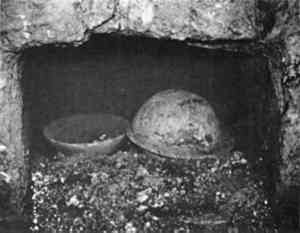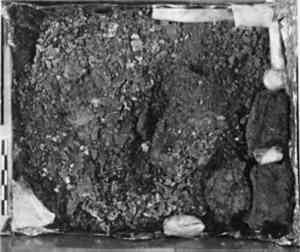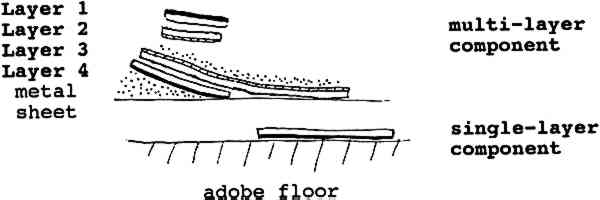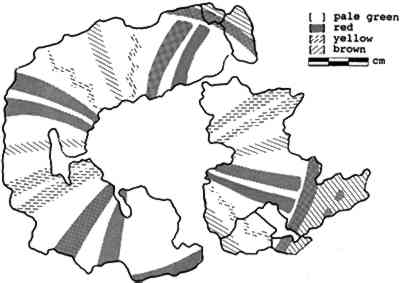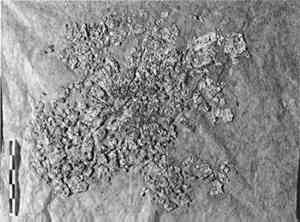FROM CODEX TO CALABASH: RECOVERY OF A PAINTED ORGANIC ARTIFACT FROM THE ARCHAEOLOGICAL SITE OF CER�N, EL SALVADORHARRIET F. BEAUBIEN
ABSTRACT—During the 1989 field season, a layered deposit of paint fragments was excavated at the site of Cer�n, El Salvador, and thought to be the remains of a classic Maya period codex. Information gained from materials analysis and conservation treatment now suggests that it once was a painted calabash (or gourd), with the strongest evidence provided by the reconstructed decorative scheme and impressions of the disintegrated substrate preserved on the fragments' reverses. Supporting archaeological and literary evidence for this interpretation is presented, and treatment procedures and mount design are discussed. 1 OVERVIEW OF THE SITEThe archaeological site of Cer�n, located approximately 25 km northwest of San Salvador, El Salvador, was once a small village located in a fertile valley not far from a modest ceremonial center, now called San Andr�s. In ca. A.D. 600, a nearby volcano erupted explosively with little warning, enveloping adobe structures, artifacts, plants, animals, and probably people in warm moist clouds of volcanic ash, and rapidly burying an approximately 20 sq km area under 4 to 6 m of tephra (the material ejected from the volcano) (Zier 1983). The site, discovered during a Salvadoran agricultural project in 1976, has been undergoing systematic excavation since 1989 under the aegis of the University of Colorado and is providing an unprecedented opportunity to study southern Mesoamerican households from the classic Maya period (Sheets et al. 1990). Due to the circumstances of its burial, the site can be dated securely to A.D. 590 � 90 on the basis of radiocarbon and archaeomagnetic analysis (Zier 1983; Wolfman 1992). Because it was catastrophically abandoned (i.e., valuables were not taken by the departing inhabitants and the site was not “mined” subsequently for useful materials), it offers a relatively comprehensive and undisturbed picture of daily life. In addition, the depth of the volcanic ash and the rapidity of its deposition have tempered the effects of some physical agents of deterioration, permitting the recovery of information that is ordinarily undetectable in the archaeological record. This information includes evidence of the cultivation and use of organic materials, such as seeds, garden plants, baskets, household furnishings, and structural elements (de Aguilar 1991a; Gerstle 1989). Some of these materials survive directly or in carbonized form. Others, now completely decomposed, are documented by molds or impressions retained in adjacent materials. The painted artifact that is the subject of this article falls into this last category. 2 DISCOVERY OF A POSSIBLE CODEXDuring the 1989 field season, a layered deposit of paint fragments was found in a niche located inside an adobe domestic building (Structure 2) (McKee 1989)(fig. 1). It occupied a rectangular area measuring 18 � 15 cm and approximately 3 cm deep. Found in the niche with the deposit were three polychrome ceramic vessels, one with food remains, and a partial marine bivalve shell. Roof thatch collapsing into the building had blocked the niche opening, preventing complete inundation of the niche by subsequent surges of tephra. The deposit was relatively undisturbed, except for a superficial accumulation of ash, charred thatch, and some fallen adobe bits from the niche's ceiling. It was, however, extraordinarily fragile and in poor condition due to the complete deterioration of the organic material on which the paint was originally applied.
At the time of their discovery and during the early stages of treatment, the paint fragments were thought to constitute the remains of a codex because of the deposit's layered structure (visible along the edges) and its flattened and rectangular format. “Codex” is a term commonly used to describe the indigenous Mesoamerican form of book. This identification prompted considerable interest among Mesoamericanists for a number of reasons. Although representations of codices appear throughout the classic Maya period in wall and pottery decoration, fewer than 15 examples have survived from Maya and neighboring cultures (Coe 1980). None of these has an archaeological provenance; all are thought to be later than the 12th century and were acquired at early dates by various library collections. Typically they are constructed of a long sheet of felted amate (a fig bark) or maguey (agave cactus) fibers, folded like an accordion (von Hagen 1977). One or both sides are painted with a white sizing or ground layer followed by figural and glyph decoration using various mineral or organic pigments. The elite context of the codices is evidenced by their royal genealogical and astronomical content (Coe 1980). Given the scarcity of these objects, the rare occurrence of layered paint deposits in archaeological contexts has occasioned reports of codex remains, although none has been successfully recovered or confirmed (Kidder et al. 1946; Angulo V. 1970; Agurcia Fasquelle and Fash 1989). If Cer�n's paint remains were of a codex, its early date, secure provenance, and non-elite context would make its recovery extraordinary. 3 LIFTING AND TRANSPORTThe archaeologists removed the deposit from the niche by sliding a metal sheet along the adobe floor (fig. 2). No subsidiary support was provided around its fragile edges either during the lift or subsequently during
The paint layer was removed using a block-lifting technique. Allowing a margin of at least 2 cm on all sides, a shallow trench was cut into the floor so that a metal sheet could be slid 3 cm below the floor surface. While necessarily damaging the niche floor, this method resulted in no disruption of the remnant paint layer. The lifted section was set into an aluminum foil-lined cardboard box, and plaster of Paris was poured around the perimeter to prevent any subsequent movement of the adobe block. The paint fragments were then cleaned with a soft paintbrush and, once tested for sensitivity to water and organic solvents, retained in position with small strips of tengujo Japanese tissue and Dow Methocel A15C methyl cellulose in water. Given the rarity of the find and the lack of instrumentation and expertise in El Salvador to carry out a thorough investigation, a cooperative agreement for temporary transfer to the United States was signed, and the two components were packed and hand carried to the Smithsonian Institution's Conservation Analytical Laboratory (CAL). In time, the artifact would be safely mounted for return to the Museo Nacional David J. Guzm�n in San Salvador. Protection in transit was provided as follows. The “multilayer component” (lifted by the archaeologists) was transferred from its plastic bag to a fitted foil-lined cardboard box. Small pillows of Saran Wrap covered cotton wool and Ethafoam blocks were used along the sides to pad the deposit in position, and the surface was protected with a layer of Pellon overlaid with cotton wool. The box was then enclosed in a plastic bag to maintain its high humidity. The “single-layer component” (lifted by the author) was similarly padded on its surface but did not require bagging, as it had been allowed to air-dry. Each component was cushioned within a wooden carrying box using blocks of Ethafoam and rolled bubble wrap. The boxes were maintained in their horizontal orientation during their transport to CAL. 4 MATERIALS ANALYSISPreliminary analysis was carried out to identify the paint fragment materials for guidance they might provide in attributing fragments to various paint layers and in treatment material choices. This analysis also was an opportunity to contribute to the inventory of pigments found in Mesoamerican contexts, the identifications of which often have not been confirmed analytically. Each fragment, no more than 0.5 mm thick, was composed of a white ground layer with one or more thinly applied pigmented layers. The results of analysis by polarized light microscopy, scanning electron microscopy (SEM) with energy dispersive x-ray analysis, and x-ray diffraction analysis methods are presented in table 1. The fragments did not disaggregate in water or organic solvents, suggesting the presence of an insoluble binder in both ground and pigmented layers. However, this finding was not confirmed with either Fourier transform infrared spectrophotometry or ultraviolet fluorescence microscopy, perhaps because of undetectably low concentration. Preserved in the white ground on the reverse of the fragments were minute impressions, the only remaining evidence of the organic material that once served as the substrate for the paint layers. They were examined using SEM, along with comparative materials; the results are interpreted in section 6. TABLE 1 ANALYSES OF MATERIALS 5 TREATMENTThe goals of the treatment were to identify the artifact through an investigation of structure and decoration and to reconstruct its remains as completely as possible. For each of the two components, the process featured the painstaking reassembly of fragments into individual paint layers using methods that would allow both sides to be accessible for examination whenever possible. Evidence for interpretation thus could be gathered from the reconstructed design scheme as well as from the overall pattern of impressions on the reverse. The process (described more fully below) revealed that the artifact consisted of four distinct paint layers (fig. 3), all of which were present in the component lifted by the archaeologists (the “multilayer component”). The uppermost layer (layer 1), polychromatic and oriented paint side up, was paired with a paint-side-down
The single-layer component was treated first because the fragments constituted only one layer and their configuration was relatively intact. Although oriented paint side down, they presented the most straightforward opportunity to recover an expanse of design. The backing strips applied on site were reinforced with additional Japanese tissue, secured to the irregular surface with methyl cellulose adhesive. It was overlaid with a layer of Saran Wrap, and a conforming support was cast in plaster of Paris. The block-lifted segment was then inverted, the plaster collar removed, and the adobe floor carefully excavated away. As fragments were revealed, their surfaces were cleaned, and they were consolidated thoroughly to the backing tissue with 5–10% w/v Acryloid B-72 (Rohm & Haas) in acetone. The multilayer component was then excavated with careful documentation after it was determined that imaging techniques were unlikely to provide usable information. Fragments were removed one by one using a dampened paint brush, delicately cleaned using deionized water or acetone, and edge-joined to reconstruct the individual layers. Jumbled fragments were collected in discrete groups for possible reintegration with the help of the documentation. Methyl cellulose was used whenever possible as the initial adhesive for edge-joining fragments. It provided a sufficiently strong temporary bond. At the same time, because fragments were manipulated frequently during this phase of treatment, it offered advantageous working properties, being both readily reversible and nonadhesive to glass or plastic work surfaces. The dilute Acryloid B-72 solution was found to function less flexibly and, for the purpose of initial reconstruction, to produce too effective an adhesive bond; in particular, joins were difficult to reverse without damaging the fragments. For final presentation, the layers were each secured in paint-side-up orientation to a tissue backing. Japanese tissue was used as the initial layer because of its exceptional ability to conform closely to fragment irregularities when adhered first with methyl cellulose. The fragments were then consolidated thoroughly to the backing tissue using Acryloid B-72 for strength and to reduce the risk of biodeterioration problems. Finally, leftover fragments whose original positions could not be ascertained were stored by location in polycarbonate boxes, available as untreated samples for future analysis if needed. Because of their disturbed condition, layers 1 and 2 could be reconstructed only in small islands. By contrast, the monochromatic layer 3 proved to be the most uninterrupted paint layer of the deposit and was of greatest interest for the extensive Since all other paint layers had been removed, the paint-side-down fragments comprising the bottom-most polychromatic layer (layer 4) were lifted in a single operation rather than one by one. This procedure permitted the noticeable concave curvature at the periphery of the layer to be maintained. The fragments were first backed with Japanese tissue and methyl cellulose adhesive. With a Saran Wrap separating layer, a conforming support was cast in plaster, the block inverted, and the metal sheet removed. Thatch and ash that had collected at the periphery were cleared from the fragments' paint surfaces, and these were consolidated to the tissue backing with Acryloid B-72. These fragments and those comprising the single-layer component were subsequently reunited on a single Japanese-tissue backing. 6 INTERPRETATION OF THE ARTIFACT REMAINSUnlike any known codex, the overall application of color and radiating design scheme of layer 4 suggest instead a rounded container with a decorated exterior, painted monochromatically on the interior (layer 3) (fig. 4). A comparable decorative approach can be found in contemporaneous Copador-style ceramics, which mimic the radiating segments of gourds or melons in their design (Beaudry 1989; SARCAR). The concave curvature around the edge of layer 4 likely reflects the original form of the artifact rather than distortion from the lifting process, ash and debris having lodged around the base prior to its collapse.
The impressions on the reverse of layer 3 offer the most persuasive argument for a gourd as the now-disintegrated organic substrate (fig. 5). They record an interlocking fibrous mesh with a coarse texture and radiating ribs, characteristic of a gourd's interior morphology (Heiser 1979; Florian et al. 1990), also seen on the reverses of layer 2
Convincing comparisons can be made with several other artifacts excavated during the 1990 field season in a structure identified as a kitchen (Structure 11) (Mobley-Tanaka 1990). Because of the relative openness of the building, these items were accessible to and engulfed by the first fine surge of tephra, which preserved the paint layers in their original configuration. In a lifting method devised by the archaeologists, the interior ash was removed, and the concavity was filled with dental plaster to provide support for the fragile paint layer that articulated the outside surface. While the plaster filling made subsequent identification of the substrate impossible, the hemispherical form of the containers was preserved. Despite their differences in preservation, these artifacts were otherwise comparable to the niche artifact in paint application technique, decorative schemes, and pigments employed. Based upon their association with either food preparation areas or ceramic serving vessels, they are all likely to have been food serving containers, although no residues were detected in any of the objects. It is quite possible that unidentified deposits of paint reported in excavations of other Maya sites once decorated organic substrates such as calabashes. One artifact from the ceremonial site of Tik�l, Guatemala, lifted in 1965 using plaster of Paris and on display in the site museum, may well be an example (Greene 1992). Even more direct evidence comes from the Sacred Cenote at the site of Chich�n Itz�, in the Yucat�n Peninsula, an important Maya ritual center (Coggins and Shane 1984; Ediger 1983). Archaeological dredgings in 1904 and more systematic underwater explorations in 1967 of this natural limestone sinkhole yielded fragments of ornately painted gourds. Edward Herbert Thompson described the findings of the earlier effort as including “gourds coated with the same whitish enamel used on terracotta vessels and painted or hieroglyphed. The gourds were undoubtedly used not only for containers for liquids but for other things such as corn and beans, as they are used by the modern Mayas” (quoted in Wilson 1947, 4). Further evidence of the use of calabashes in the daily life of the Maya is detailed in an account written in 1566 by the Spanish prelate Diego de Landa. In Relaci�n de las Cosas de Yucat�n, he writes in the section on food 7 MOUNTING FOR TRANSPORT, DISPLAY, AND STORAGEConsiderations for mounting the fragmentary remains of Cer�n's painted calabash included the need to provide ample physical protection with a simple yet flexible design utilizing stable and reversible materials. These factors were of particular importance given staff limitations and lack of environmental controls in El Salvador's museums. Rather than presenting the remains in an interpretive reassembly of the object, the mount was designed more neutrally to reproduce the as-found, collapsed state of the object, as some questions still remained about its exact dimensions, curvature, and the full reconstruction of the upper two layers (fig. 6). An assumption was made that the viewer would want to see the painted side of the layers, even if they were originally oriented paint side down (such as layer 4). Information gleaned from the treatment could be presented using photographs, diagrams, and painted facsimiles, which would provide a more coherent interpretation than could the remains themselves.
The mount consists of a series of equal-sized Plexiglas acrylic sheets, each of which supports an individual paint layer. The paint layers were prepared by reinforcing the Japanese tissue backings with additional layers of Pellon 6800 polyester web, adhered with Acryloid B-72 (20% w/v in acetone). The backing was then trimmed to a uniform For display, the sheets can be stacked with the decorated layer (layer 4) in its inverted, as-found orientation (fig. 7); a mirror mounted below allows the layer to be viewed. Varied spacing and arrangement of sheets may be accommodated by altering the length of acrylic rods and tubes, which act as spacers as well as supports for the individual layers; alternatively, the sheets may be disassembled and displayed side by side. To minimize handling and provide maximum protection in storage and during transport, each paint layer is held securely in a sturdy Fome-Cor mat with a deep well. These mats stack into a clamshell box made of acid-free cardboard along with a box containing the display mount components.
8 CONCLUSIONSWith deceptive archaeological deposits such as these, careful lifting techniques are necessary to preserve the evidence properly, as are considerable conservation efforts in order to confirm an identification. The treatment of this painted calabash demonstrates the amount of information that is retrievable from poorly preserved evidence and suggests some techniques that can be used effectively. In Mesoamerican studies, it is hoped that this work will sound a cautionary note regarding artifact interpretation. In doing so, however, it also provides a step toward elucidating what we can assume is a much broader inventory of painted organic materials, not limited to highly specialized codices, which only a few sites such as Cer�n give us the opportunity to recover. ACKNOWLEDGEMENTSThis treatment reflects the input of specialists in many disciplines. I would especially like to acknowledge my co-workers at the Conservation Analytical Laboratory, with many thanks to Mark Fenn for his assistance with the mount. The collaboration of conservation and archaeology that this work initiated has been well fostered by Payson D. Sheets and the Cer�n Project team members. None of this work would have been possible without the support of CONCULTURA in El Salvador's Ministry of Education and the staff of the Museo Nacional David J. Guzm�n, who have been REFERENCESAll treatment documentation is on file at the Conservation Analytical Laboratory under CAL# 5168; duplicates are kept by Payson D. Sheets at the Department of Anthropology, University of Colorado and by CONCULTURA in the Ministry of Education, El Salvador. Agurcia Fasquelle, R., and W. L.Fash, Jr.1989. Cop�n: A royal Maya tomb discovered. National Geographic176(4):480–87. Angulo V., J.1970. Un posible c�dice de El Mirador, Chiapas. Tecnologia4. Mexico City: Instituto Nacional de Antropologia e Historia. Beaudry, M. P.1989. Ceramics. In 1989 Archaeological investigations at the Cer�n site, El Salvador: A preliminary report, ed.P. D.Sheets and B. R.McKee. Boulder: Department of Anthropology, University of Colorado. 81–90. Coe, M. D.1980. The Maya. New York: Thames and Hudson. Coggins, C. C., and O. C.ShaneIII, eds.1984. Cenote of sacrifice: Maya treasures from the sacred well at Chich�n Itz�. Austin: University of Texas Press. deAguilar, M.L.R.1991a. Una verdadera joya; Joya de Ceren: Flora autoctona Salvadorena. PANKIA: Bolet�n Informativo Jard�n Bot�nico La Laguna (April–June):3–9. deAguilar, M.L.R.1991b. El Morro. PANKIA: Bolet�n Informativo Jard�n Bot�nico La Laguna (July–September):2–6. deLanda, Fr. Diego. 1937. Yucat�n before and after conquest, trans. W. Gates. 2d ed.Baltimore, Md.: Maya Society. Ediger, D.1983. The well of sacrifice. Garden City, N.J.: Doubleday & Co. Florian, M. E., D. P.Kronkright, and R. E.Norton. 1990. The conservation of artifacts made from plant materials. Malibu: J. Paul Getty Trust. Gerstle, A. I.1989. Organic remains. In 1989 Archaeological investigations at the Cer�n site, El Salvador: A preliminary report, ed.P. D.Sheets and B. R.McKee. Boulder: Department of Anthropology, University of Colorado. 109–10. Greene, V.1992. Personal communication. University Museum, University of Pennsylvania, Philadelphia, Pa. Heiser, C. B., Jr.1979. The gourd book. Norman: University of Oklahoma Press. Heiser, C. B., Jr.1992. Personal communication. Department of Biology (emeritus). Indiana University, Bloomington, Ind. Kidder, A. V., J. D.Jennings, and E. M.Shook. 1946. Artifacts: Perishable Substances. In Excavations at Kaminaljuyu, Guatemala. Publication 561. Washington, D.C.: Carnegie Institution of Washington. 98–102. McKee, B. R.1989. Excavations at structure complex 2. In 1989 Archaeological investigations at the Cer�n site, El Salvador: A preliminary report, ed.P. D.Sheets and B. R.McKee. Boulder: Department of Anthropology, University of Colorado. 41–58. Mobley-Tanaka, J.1990. 1990 Excavations in operation 1. In 1990 Investigations at the Cer�n site, El Salvador: A preliminary report, ed.P. D.Sheets and B. R.McKee. Boulder: Department of Anthropology, University of Colorado. 36–47. SARCAR (Smithsonian Institution Archeometric Research Collection and Records). Maya Ceramics Survey, photographic files. Smithsonian Institution, Conservation Analytical Laboratory. Sheets, P. D., H. F.Beaubien, M.Beaudry, A.Gerstle, B.McKee, C. D.Miller, H.Spetzler, and D. B.Tucker. 1990. Household archaeology at Cer�n, El Salvador. Ancient Mesoamerica1:81–90.
vonHagen, V. W.1977. The Aztec and Maya papermakers. New York: Hacker Art Books. Wilson, E. W.1947. The gourd in folk literature. Boston: Gourd Society of America. Wolfman, D.1992. Personal communication. Office of Archaeological Studies. Museum of New Mexico, Santa Fe, N.M. Zier, C. J.1983. The Cer�n site: A classic period Maya residence and agricultural field in the Zapotit�n Valley. In Archeology and volcanism in Central America: The Zapotit�n Valley of El Salvador. ed.P. D.Sheets. Austin: University of Texas Press. 119–43. OTHER SOURCESBeaubien, H. F.1989. Conservation report on Cer�n folio. In 1989 Archaeological investigations at the Cer�n site, El Salvador: A preliminary report. ed.P. D.Sheets and B. R.McKee. Boulder: Department of Anthropology, University of Colorado. 105–8. Beaubien, H. F.1990. Conservation report: 1990 season. In 1990 Archaeological investigations at the Cer�n site, El Salvador: A preliminary report. ed.P. D.Sheets and B. R.McKee. Boulder: Department of Anthropology, University of Colorado. 148–52. Beaubien, H. F.1990. Technical analysis of pigment materials. In 1990 Archaeological investigations at the Cer�n site, El Salvador: A preliminary report. ed.P. D.Sheets and B. R.McKee. Boulder: Department of Anthropology, University of Colorado. 189–91. AUTHOR INFORMATIONHARRIET F. (RAE) BEAUBIEN has been an objects conservator at the Smithsonian Institution's Conservation Analytical Laboratory since 1988. She holds a B.A. in art from Beloit College, an M.A. in art history from the University of Chicago, and is a graduate of the New York University Institute of Fine Arts' conservation training program. Since 1980 she has worked on a variety of archaeological projects, primarily as an on-site conservator. Address: Conservation Analytical Laboratory, Museum Support Center, Smithsonian Institution, Washington D.C. 20560-0001.
 Section Index Section Index |
